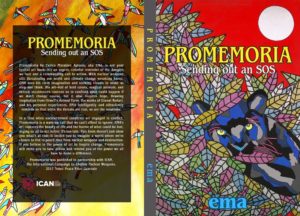PROMEMORIA (2024)

Book overview
In Promemoria, artist and activist Enrico Muratore Aprosio, aka EMA, uses his unique style to address some of the biggest threats to our world today—nuclear war, climate change, and human rights abuses. Through colorful, imaginative, and sometimes unsettling images, EMA calls attention to the global issues that put humanity and the natural world at risk. Inspired by his own experiences during the COVID-19 pandemic and works of literature like Orwell’s Animal Farm, EMA’s art speaks volumes about the fragility of our existence and the choices we face and make. His artwork combines bright colors, beautiful animals, and surreal, magical scenes to deliver an urgent message: we are running out of time to make the changes needed to prevent disaster. In a world where nuclear weapons still exist and conflicts between powerful nations continue to escalate, EMA’s creations invite us to reflect on what we value and what we’re willing to fight for.
This book isn’t just a collection of beautiful art—it’s a wake-up call. EMA’s use of symbolism, from nuclear mushrooms to combative animals, brings the viewer face-to-face with the dangers that hover over us all. Yet there’s hope here: his art reminds us that while humanity has created these threats, we can solve them. Promemoria is a vibrant reminder of what’s at stake and a passionate plea for a nuclear-free, peaceful future. Through his work, EMA calls us to imagine a different world—one where we rise above our worst instincts and embrace the possibility of peace and renewal.
Promemoria – Reminder
Works and writings by Ema (2020 – 2024)
The years 2020 to 2024 saw a steady escalation of global threats and increased fear and anguish within all humans, worsening their already precarious mental health: the experience of the Coronavirus pandemic,with the lasting changes it brought to human societies, followed by a scary cycle of expanding murderous wars in violation of international law, and, last but not least, the threatened use of nuclear weapons.
Suddenly, we fell into a neo-Orwellian cold war: Good against evil, we don’t talk with the enemy—no space for diplomacy or international cooperation. Poverty and inequalities, the planet is destroyed. The human species is confronted, more than ever before, with the risk of self-extinction.
The end of history. The end of art.
In a post-nuclear world, Chauvet, the pyramids, Palmyra, Phidias and Pompei, the Machu-Picchu, the Sistine Chapel or the Taj Mahal, Mona Lisa, Artemisia Gentileschi, Caravaggio, Monet, Duchamps, Picasso, Kahlo, Pollock, Warhol, Basquiat, Banksy, Hirst and Botero, and all the music, all the literature, the poetry and cinema, will be nothing but a worthless pile of post-atomic rubble, torched wreckages of dead civilizations, buried under the nuclear fallout, and forgotten forever in this remote, insignificant portion of the universe.
In times of artificial intelligence, EMA’s paintings reflect around what is left of the simple common sense of everyone.
Other species of mammals, birds, invertebrates, live, in average, for one to ten million years; we, the homo sapiens, have been around for only 2-3 hundred thousand years. Going extinct quicker than invertebrates is not a glorious demonstration of intelligence.
EMA tries to understand why this pandemic of madness has infected the human species, using his contrasting, bright neon colours, to develop alternative worlds, populated either by happy animals and joyful children living in peace, or by metaphysics, soulless radioactive beasts and dead piles of irradiated human bones, immobile in front of the Hiroshima animal farm, a huge mushroom of fire and ashes hiding the sun for a long, cold winter.
Maybe we should think more about the world we want for our children. Reminding that
There are things to never do,
neither day nor night,
neither by sea nor by land
For example, war
(Gianni Rodari)